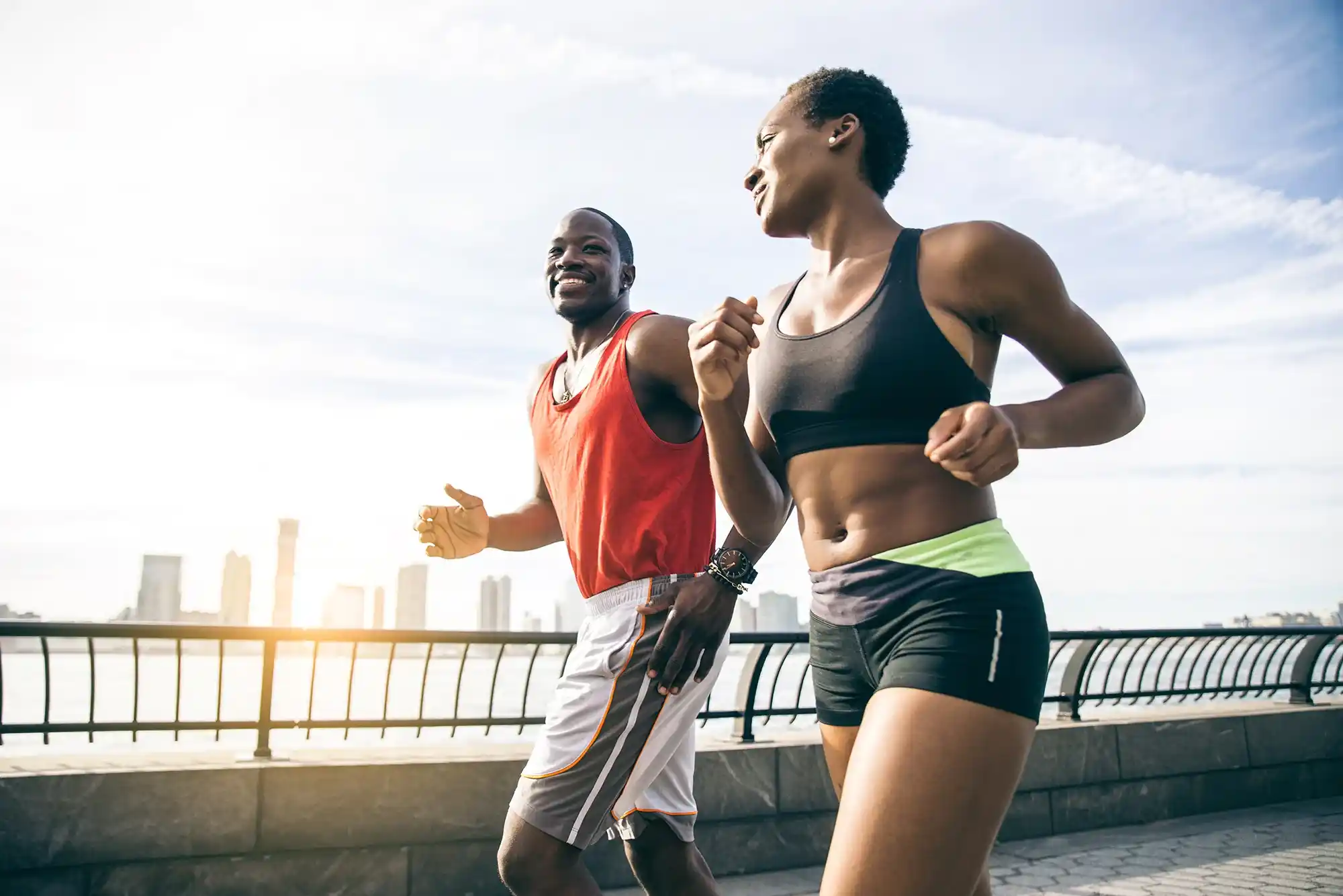Let’s face it – you have probably been told to get some fresh air on more than one occasion – and for good reason! The great outdoors is responsible for some of the greatest experiences in life, so you may want to listen the next time someone tells you to go out and smell the roses.
Outdoor activity is an essential component to healthy living and is a great way to support your mental and physical wellbeing. Running, bike riding, and swimming are just a few fun and exciting activities to participate while outdoors, especially if you’re looking to save a few bucks on your physical wellness journey.
The amount of ideas that concern outdoor activity are endless – especially when you live near a park, mountain trail, or lake. Although it is nearly impossible to whittle down all types of outdoor activity, it helps to compile a list of some things to do that are both highly effective and fun! With that said, we’ve compiled a list of five notable outdoor activities to participate in. Although each activity brings its own unique set of benefits, each of these was selected for how they specifically help support your physical health.
1. Jogging/Running
Suggested Equipment:
- Comfortable athletic sneakers (strongly recommended)
When put against other top outdoor activities, running is perhaps the most easy and accessible activity to support physical health. The beauty of running lies within its simplicity – all that’s needed is a pair of sneakers and your own self!
Running is one of the most versatile physical activities – there’s really no “wrong” way of going about it. For example, the average adult might seek to jog thirty minutes a day, while a more advanced runner might aim to run for a couple hours at a time. The point of this is to understand the many ways running can benefit your physical health.
Harvard Health Blog supports this very same idea; even the most recreational of jogs supports your physical health, but a more advanced running session will most likely provide a greater benefit to your physical wellbeing. In fact, according to a 2013 study, just 2.5 hours per week could serve as the “sweet spot” for an ideal jogging or running plan. Running makes you feel better and even brightens your mood on a daily basis, the cardiologist proclaims.
Put simply, jogging and running are highly effective workouts to support physical health. Although running could provide you with a generally positive attitude, it actually targets different key areas throughout your body that includes cardiovascular health, strength in bones, and muscle building because of the weight-bearing nature that comes with running.
2. Yoga
Suggested Equipment:
- Yoga Mat (recommended)
The next activity for physical health support is perhaps the most intriguing because of its rich history. Yoga has been practiced for over 5000 years – a testament to just how effective and beneficial this activity really is. Although many have turned to this activity to provide physical support for thousands of years, Yoga is in the midst of a renaissance. In fact, Yoga aficionados have seen their beloved exercise has grown over 50% in popularity from 2012 to 2016. Adults over the age of 50 have begun to partake, as over 14 million people in this age group say they use Yoga to help take care of their physical wellbeing.
An outdoor setting is ideal for practicing Yoga, but don’t let that stop you from completing some rainy-day Yoga sessions in your own home! Studies have shown an increased effectiveness in Yoga when completed outdoors, the main reason being the impact nature has on stress. Plus, it’ll allow you to bask in the warm rays of sunshine and soak up some Vitamin D, but as always, make sure to do so in a responsible manner!
Although this article focuses on physical health, it’s important to know that too much stress could leave a negative impact on your muscles, brain function, and more. That said, while the great outdoors could provide a more complete Yoga experience, there is absolutely nothing wrong with practicing this activity in the confides of your own home.
Similar to other forms of physical activity, Yoga supports your physical health in more ways than one. Like jogging and running, Yoga supports muscle strength, but could provide a different set of benefits as well. For example, an increased flexibility in limbs is one of the most popular benefits of Yoga. Plus, support for energy, vitality, and even your respiratory system are all additional benefits of Yoga.
3. Biking
Suggested Equipment:
- Bicycle
- Helmet (strongly recommended)
The next physical activity has seen a steady increase in participants over the last two decades – a welcoming sign for the health and wellness of future generations. The United States is home to approximately 48 million people who bike ride, a 23% increase in participants since 2006. Two different but related ideas are responsible for the rise in popularity; physical health and protecting the environment are considered the best reasons why people have opted for the bike over other forms of transportation.
Like Yoga, this method of physical activity provides a wide array of support for health, but it is exciting to realize the environmental benefits that come along with bike riding as well! For the sake of this article, however, we’ll focus on the positive impact this activity has on physical health and wellness.
When it comes to biking, there are different ways to actually participate. If you tend to lean towards the leisure aspect of bike riding, you may want to use a safe and paved road in your hometown. For those who seek adventure, check out some of the top bike trails in the United States. These trails are scattered throughout the country and could end up being the destination of your next road trip!
Whether you prefer to take a leisurely ride around your block, explore some pathways in the park near your home, or put your skills to the test and adventure up those tricky trails, this activity provides tons of benefits for your physical health. According to the Harvard Health, the health benefits of regular cycling include:
- Increased stamina and endurance
- Increased muscle strength and flexibility
- Improved joint mobility
- Strengthened bones
- Support for your cardiovascular system
Keep in mind, bike riding is considered a low impact activity – meaning it causes less strain on your body than jogging or running, as long as you ride in a safe and responsible manner.
4. Swimming
Suggested Equipment:
- Goggles (recommended)
- Swim cap (recommended)
Swimming, another light impact physical activity, is enjoyed by nearly all age groups in the United States. Some swim for fun, while others dive into the water to support their physical health and wellbeing. And if you don’t like to swim, there are plenty of pool exercises that are less strenuous than conventional workouts at the gym. In fact, activities such as jogging, running, and even weightlifting are easier on the body while in water. Some benefits of exercising in water include:
- Lower impact on your joints
- Greater weight resistance while working out
- Allows your body to cool off faster to reduce the risk of overheating during exercise
That being said, not everyone likes to work out in water. Some of us rather dive into perfect our backstroke or master the doggy paddle in the deep end of the pool. Others opt to float around the surface of the water and soak in some rays on a sunny day – just make sure to use sunscreen!
As mentioned, swimming is an optimal activity to support your physical health because it puts less stress on the body. Simply put, it is a low impact form of exercise that is not only effective but highly enjoyable as well! The butterfly, backstroke, and breaststroke are among the most popular swimming strokes. And of course, there’s the ever-popular freestyle. Each form takes on its own unique style and movement and benefits your body in different ways.
The breaststroke is among the most basic of swimming forms, so it might be a good idea to kick off your work out with this particular style. Don’t let the simplicity of this stroke fool you, however – Swimming.com considers the breaststroke a much better workout for cardiovascular health than its counterparts. This stroke supports your thighs, upper back, triceps, hamstrings, and lower legs, in addition to your heart and lungs. Learn how to improve your form by watching this brief but informative clip.
The next swimming stroke to focus on is the backstroke. Unlike the breaststroke, this style focuses on your hips to keep them flexible and limber – an ideal workout for those who find themselves sitting in an office chair for hours at a time. Plus, the backstroke offers support for the stomach, arms, shoulders, and buttocks. The breaststroke and backstroke offer a balanced pool workout for a number of key areas of physical health, without putting too much stress on your body. If you’re looking to master this stroke, check out this instructional video.
The final stroke to consider is the butterfly. Although this stroke is not ideal for beginners, it is the most effective swim style in terms of toning and building muscle. The butterfly is the most complicated of the three strokes, but that shouldn’t take away from any of the benefits it has to offer. It is your best bet to support your upper body and flexibility because it targets your chest, stomach, and triceps. The flexibility aspect comes into play because this form requires constant stretching – an ideal workout if you’re looking to increase suppleness and improve posture. Check out this instructional video for reference.
5. Kayaking
Suggested Equipment:
- Kayak
- Paddle (2)
- Life Vest (strongly recommended)
The final activity to support your physical health is also found in water – but doesn’t require swimming – that is, unless you fall in (which is why we emphasize the need for a Life Vest)! Although this activity isn’t as easy to access as jogging/running, yoga, or even bike riding, you’ll notice a steady increase in popularity throughout the country.
Although most people prefer to carry out this activity on flatwater, there are several types of kayaking to choose from:
- Flatwater – The standard kayak workout is found in flatwater. As mentioned, most people opt to kayak in safe waters that don’t offer much in terms of currents, waves, or other potential risks. If you’re looking to do some sightseeing on your journey to support your physical health, then this is the way to go.
- Surf Kayaking – This activity is less popular than the typical flatwater style, but still plenty useful, nonetheless. The title all but sums this one up – a style of kayaking in which you utilize the ocean waves for a more strenuous workout. Similar to flatwater, this particular type of kayaking supports cardiovascular health, along with muscle strength in your back, arms, shoulders and chest, and legs.
- Whitewater Kayaking – If you’re looking for an extreme kayaking experience, perhaps whitewater kayaking is for you! It is important to note that you will most likely experience treacherous conditions and rocky waters, so make sure to master the basics of flatwater kayaking before advancing to the next level!
Each of these types of kayaking support a number of key areas throughout your body. It is easy to realize the support this activity brings to your upper body, don’t forget about your legs! In fact, kayaking promotes muscle building in your legs – especially when you kayak with proper technique. Now that we’ve covered some common types of kayaking, let’s take a look at how it supports your physical health:
- Upper Body Strength – Paddling for hours at a time will certainly do a number on your arms. Fortunately, this is a low impact activity that allows you to efficiently support your triceps, shoulders, chest, and even upper back.
- Core Conditioning – Twisting is required to properly paddle a kayak. This motion helps support your upper and lower abdomen while allowing you to gain more balanced and control in your core.
- Leg Strength – Your legs provide stability and balance to the kayak. In order to sustain control, your legs apply pressure to safely maneuver your paddleboat. This action promotes muscle growth and tone in your lower half.
As mentioned, outdoor activity is a key component on your journey to physical health and wellness. There are tons of effective workouts – whether big or small – that are both fun and great ways to support your physical health. And as always, remember to exercise in a safe and responsible manner, apply sunscreen, and wear other protective equipment when necessary.
Sources
https://academic.oup.com/aje/article/177/7/683/91486
https://www.ncbi.nlm.nih.gov/pmc/articles/PMC2793346/
https://www.statista.com/statistics/191204/participants-in-bicycling-in-the-us-since-2006/
https://dailyburn.com/life/fitness/best-bike-trails-america/
https://www.health.harvard.edu/staying-healthy/the-top-5-benefits-of-cycling
https://www.swimming.org/justswim/best-swimming-stroke-for-weight-loss/
https://www.swimming.org/masters/improving-your-breaststroke-technique/
https://www.swimming.org/masters/improving-your-backstroke-technique/
https://www.swimming.org/masters/advanced-butterfly-stroke-technique/
https://www.statista.com/statistics/191249/participants-in-kayaking-in-the-us-since-2006/
https://www.liveabout.com/types-of-kayaks-and-kayaking-2555726









